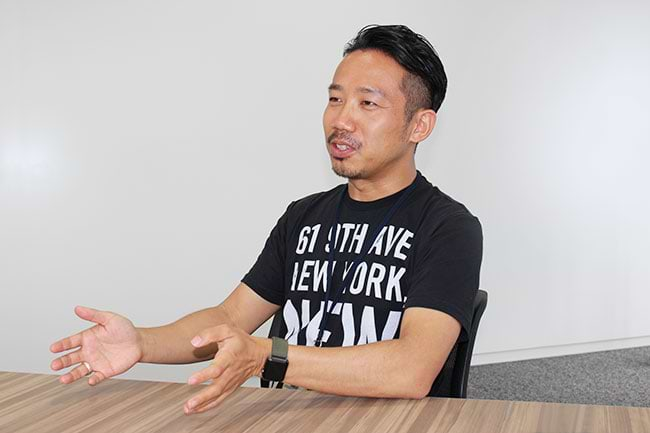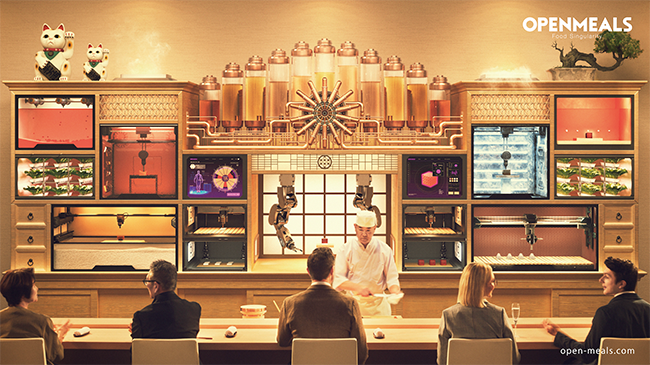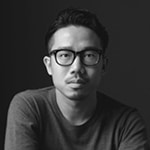Held in the spring of each year in the United States, South by Southwest (SXSW) is a conglomerate of music, film, interactive media festivals and conferences. Large numbers of companies and creatives from around the world participate in the events and talk sessions, and exhibit products and works that offer a glimpse of the future. New technologies and business ideas are showcased at the SXSW Interactive Festival, which is well known for drawing attention to newly launched services-including some that went on to become global successes, like Twitter and Airbnb. At this year’s festival, as well, all kinds of new business seeds were put on display.
Dentsu exhibited four different projects in the festival’s trade show this year under the development concept Pointless Brings Progress, which we featured in the first installment of this series. In the four subsequent articles of the series, we are giving the spotlight to the creatives who oversaw the development and production of each exhibited project.
For this installment, we spoke with Ryosuke Sakaki, an art director at Dentsu’s Creative Planning Division 3 and also the founder of Open Meals. He oversaw Dentsu’s Sushi Singularity exhibit at SXSW this year. This was his second time to be involved at the event after making a splash last year with Dentsu’s exhibit of Sushi Teleportation, a project that digitizes food and produces it remotely using a specialized 3D printer. He explained his aspirations to be involved in projects that go beyond his role as an art director.

It will be possible to produce and eat meals from anywhere in the world-and even in outer space
Please tell us about Sushi Singularity.
Sushi Singularity is the latest project of Open Meals. The project involves digitizing information about food and sharing the data via the internet. We believe this could have a big impact on the future in two ways: firstly, it will change how food will be created and consumed by people around the world, and secondly, it will allow people to personalize the food they eat. We presented the project at SXSW using the motif of sushi. We also envision the creation of an ultra-futuristic restaurant that will allow people to experience this vision of the future of food.
Open Meals was started four years ago by a team that leads projects aimed at “teleporting” food. Food teleportation involves digitizing the components that make up food, such as its shape, taste, and texture, and then reproducing the food by using a technology such as 3D printing.
People generally regard the food they eat as something made at home or prepared by a chef. By contrast, we will be able to share whatever food we want anywhere in the world if the food is digitized so that it can be produced by machines. For example, in comparatively poor countries, areas damaged by a disaster, or even in outer space, people will be able to eat a wide range of meals as long as such machines are present. Furthermore, because the components of food have been digitized, people around the world will be able to explore all kinds of meals, create their own recipes, and share them online. That could lead to a constant stream of innovative meals and recipes in the future.
This approach could also revolutionize personal healthcare. In the future, we can assume that people will be able to easily check their own DNA and nutritional status. Based on that data, it will be possible to produce food that suits each person’s body and to optimize one’s diet, such as by supplementing deficient nutrients.

Last year at SXSW, Open Meals demonstrated how sushi created in Tokyo could be instantaneously produced in the United States using a 3D laser printer designed as a robot arm. That exhibit unveiled our vision of food teleportation. After that, we carried out research and development in collaboration with various experts, and are now making concrete plans for an actual ultra-futuristic restaurant that will use the food teleportation technology. Our plan for that restaurant along with some of the machines that will be used, were put on display at our Sushi Singularity exhibit at SXSW this year.
Just like the previous year, the reaction at this year’s event was fantastic. Even recently, offers and inquiries from people in Japan and other countries have been coming in one after another. We are already working together with various organizations and specialists, and we want to collaborate with a wide range of other people in the future.
Applying printer technology to flavor opened up a completely different world of possibilities
Given your job as an art director, how did you first become involved in a project about “food teleportation”?
Food teleportation was an idea presented in a competition within Dentsu about four years ago with the goal of finding solutions for all kinds of issues facing people today, not just those in the advertising industry.
The work of an art director begins from the initial conceptual stage, and at that stage of this project, I wondered if flavors could be created in the same way that colors are combined in the printing process. All printed materials today, including posters and photographs, are reproductions of a wide range of visuals made possible by blending and modifying the ratio of four colors: cyan, magenta, yellow, and black. Applying the same approach, I attempted to literally print flavor using a standard printer, setting sweet, sour, salty, and bitter as the four components of taste. Filling up ink cartridges with flavorings like soy sauce and vinegar, I tried printing on edible paper. It is funny now, but when I first tried eating it, the flavor was completely awful. Nevertheless, by adjusting the proportion of the mixture components, I was able to adjust the quality and change the flavor accordingly. Then I realized that if exact data could be precisely controlled, it would be possible to reproduce taste in the same way color is reproduced.
Obviously, printers and color reproduction methods are part of an art director’s ordinary work, but by changing just one factor of that approach, I opened up a completely different world of possibilities. From that point onward, I searched for people to do research on preparing food using flavor data and 3D printers, and found a growing number of collaborators. The commercial viability of the project was also very important. The food market is much larger than I had originally thought, and there is now a huge amount of investment in food technologies in the food industry. Given the prospects for growth in the food-related technology industry, we moved ahead with the project at full steam. Then we continued to refine various aspects of the project to the point we have reached now.
The skills of advertising creatives can help resolve issues confronting people today
Why did you pursue activities outside of your profession as an art director, and what do you hope to accomplish in the future?
For me, design has always been just a tool for getting results. I am more interested in how to get people excited and stimulate reactions from the general public. Following that approach, I have gradually moved beyond the realm of design. In the past, I would formulate the initial strategies of a project myself, and on that basis, start trying out a combination of various methods, such as visual design, commercials, PR, and ad campaigns. After that, I would consider how to make use of my designs and creative ideas for the benefit of people and society in general.
There are many opportunities to make use of an ad creative’s skills outside of advertising, so I think this field can still become much broader. For example, art directors and copywriters work together on the messages of advertisements, and, consequently, create better ad messages. That can be thought of as “creative direction 1.0.” The next level of “2.0” involves collaboration between people like digital creatives and PR planners to produce a more complex and comprehensive brand experience. That is how advertising has evolved so far. We could, however, assemble ad teams in collaboration with professionals from outside of the advertising industry, such as researchers, engineers, academics, government officials, and lawyers, and under our direction, help create future businesses and industries. That would be “creative direction 3.0.” I think we can evolve to that level if the skills of ad creatives are made use of in that way.
Personally, I love working together with all kinds of people to create new value. Open Meals involves people from a broad range of industries, such as engineers who specialize in things like digitizing food and 3D printers, as well as experts in healthcare-related technology, chefs, and designers. Bringing all of their wide-ranging skills together to produce something new for the future is very exciting, and I hope to be instrumental in making that happen. When doing so, what I can do is visualize the expertise and capabilities of such a diverse group of people into a single, composite picture. As an example, I created the visual of an ultra-futuristic restaurant for Sushi Singularity. The visual does not depict a fanciful image of my own imagination; it is based on the scientific evidence I discussed with experts from various fields. For instance, I used that information to depict the shape of each food fabrication machine and the details of the formation methods. I also selected the placement of the selective laser sintering (SLS) 3D printers based on their weight.

I visualize such images because it provides a means of clarifying the goals I want to achieve and to instigate discussions with people, including those from different backgrounds. Visuals are the most powerful universal forms of communication, and they can clearly show the way forward. If I create a composite picture that reflects the things I discussed with each person involved, it is helpful for elucidating their ideas and exchanging viewpoints with people from various areas of expertise.
I think that the ability to combine and visualize the input of diverse people as a single image is always relevant in business, and an important skill for art directors to have and acquire. I have come to appreciate the importance of this knowhow through my experience at Open Meals. It is an especially vital skill for developing really innovative products, businesses, and industries in collaboration with a wide range of specialists. I plan to develop this visualization approach into a method in the future, and present it in detail when the opportunity arises.

Ryosuke Sakaki
Art Director and Founder of Open Meals
Creative Planning Division 3
